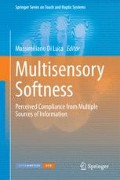Abstract
Softness can be physically expressed in different ways, for example as a stiffness value (spring constant), compliance value (the inverse of stiffness), or Young’s modulus. The relation between these quantities is discussed, as well as the psychophysical techniques for characterising the perception of these quantities. For perception of softness, multiple cues are available: visual cues include the deformation of the material around the fingers, while haptic cues include the ratio between applied force and resulting displacement of the material, and the force distribution over the contact area. Furthermore, to register these haptic cues, both cutaneous and kinaesthetic information can be used. The role of these different cues and types of information is discussed and also the interaction between the hand and the deformable material.
Access this chapter
Tax calculation will be finalised at checkout
Purchases are for personal use only
References
Bergmann Tiest WM, Kappers AML (2009) Cues for haptic perception of compliance. IEEE Trans Haptics 2(4):189–199
Bicchi A, Scilingo EP, De Rossi D (2000) Haptic discrimination of softness in teleoperation: the role of the contact area spread rate. IEEE Trans Robot Autom 16(5):496–504
Drewing K, Ramisch A, Bayer F (2009) Haptic, visual and visuo-haptic softness judgments for objects with deformable surfaces. In: Hollerbach J (ed) Proceedings of the 3rd joint EuroHaptics conference and symposium on haptic interfaces for virtual environment and teleoperator systems, Salt Lake City. USA, UT, IEEE, pp 640–645
Forrest N, Baillie S, Kalita P, Tan HZ (2011) A comparative study of haptic stiffness identification by veterinarians and students. IEEE Trans Haptics 4(2):78–87
Freyberger FKB, Färber B (2006a) Compliance discrimination of deformable objects by squeezing with one and two fingers. In: Proceedings of EuroHaptics, pp 271–276.
Freyberger FKB, Färber B (2006b) Psychophysics and perceiving granularity. In: Proceedings of the 14th symposium on haptic interfaces for virtual environment and teleoperator systems. IEEE, pp 387–393.
Friedman RM, Hester KD, Green BG, LaMotte RH (2008) Magnitude estimation of softness. Exp Brain Res 191(2):133–142
Gurari N, Kuchenbecker KJ, Okamura AM (2009) Stiffness discrimination with visual and proprioceptive cues. In: Hollerbach J (ed) Proceedings of the 3rd joint EuroHaptics conference and symposium on haptic interfaces for virtual environment and teleoperator systems, Salt Lake City. USA, UT, IEEE, pp 121–126
Harper R, Stevens SS (1964) Subjective hardness of compliant materials. Q J Exp Psychol 16: 204-215.
Jones LA, Hunter IW (1990) A perceptual analysis of stiffness. Exp Brain Res 79(1):150–156
Kuschel M, Freyberger F, Färber B, Buss M (2008) Visual-haptic perception of compliant objects in artificially generated environments. Visual Comput 24(10):923–931
Kuschel M, Di Luca M, Buss M, Klatzky RL (2010) Combination and integration in the perception of visual-haptic compliance information. IEEE Trans Haptics 3(4):234–244
LaMotte RH (2000) Softness discrimination with a tool. J Neurophysiol 83(4):1777–1786
Lécuyer A, Coquillart S, Kheddar A, Richard P, Coiffet P (2000) Pseudo-haptic feedback: can isometric input devices simulate force feedback? In: Proceedings of the virtual reality annual international symposium, pp 83–90.
Nicholson L, Adams R, Maher C (1997) Reliability of a discrimination measure for judgements of non-biological stiffness. Manual Ther 2(3):150–156
Nicholson L, Adams R, Maher C (2000) Magnitude estimation of manually assessed elastic stiffness: stability of the exponent. Percept Mot Skills 91:581–592
Scilingo EP, Bianchi M, Grioli G, Bicchi A (2010) Rendering softness: integration of kinaesthetic and cutaneous information in haptic devices. IEEE Trans Haptics 3(2):109–118
Scott Blair GW, Coppen FMV (1939) The subjective judgements of the elastic and plastic properties of soft bodies; the “differential thresholds” for viscosities and compression moduli. Proc R Soc Lond Ser B Biol Sci 128(850):109–125
Srinivasan MA, LaMotte RH (1995) Tactual discrimination of softness. J Neurophysiol 73(1): 88-101.
Srinivasan MA, Beauregard GL, Brock DL (1996) The impact of visual information on the haptic perception of stiffness in virtual environments. Proc ASME Dyn Syst Control Div 58:555–559
Tan HZ, Durlach NI, Beauregard GL, Srinivasan MA (1995) Manual discrimination of compliance using active pinch grasp: the roles of force and work cues. Percept Psychophysics 57(4):495–510
Varadharajan V, Klatzky R, Unger B, Swendsen R, Hollis R (2008) Haptic rendering and psychophysical evaluation of a virtual three-dimensional helical spring. proc. In: Symposium on haptic interfaces for virtual environments and teleoperator systems. IEEE, pp 57–64.
Wichmann FA, Hill NJ (2001) The psychometric function: I. Fitting, sampling, and goodness of fit. Percept Psychophysics 63(8):1293–1313.
Wu WC, Basdogan C, Srinivasan MA (1999) Visual, haptic, and bimodal perception of size and stiffness in virtual environments. Proc ASME Dyn Syst Control Div 67:19–27
Acknowledgments
This work has been partially supported by the European Commission with the Collaborative Project no. 248587, “THE Hand Embodied”, within the FP7-ICT-2009-4-2-1 program “Cognitive Systems and Robotics”.
Author information
Authors and Affiliations
Corresponding author
Editor information
Editors and Affiliations
Rights and permissions
Copyright information
© 2014 Springer-Verlag London
About this chapter
Cite this chapter
Bergmann Tiest, W.M., Kappers, A.M. (2014). Physical Aspects of Softness Perception. In: Di Luca, M. (eds) Multisensory Softness. Springer Series on Touch and Haptic Systems. Springer, London. https://doi.org/10.1007/978-1-4471-6533-0_1
Download citation
DOI: https://doi.org/10.1007/978-1-4471-6533-0_1
Published:
Publisher Name: Springer, London
Print ISBN: 978-1-4471-6532-3
Online ISBN: 978-1-4471-6533-0
eBook Packages: Computer ScienceComputer Science (R0)

